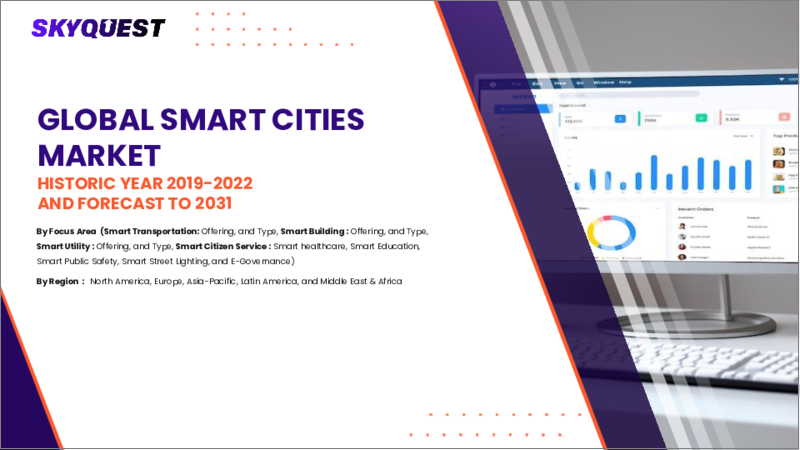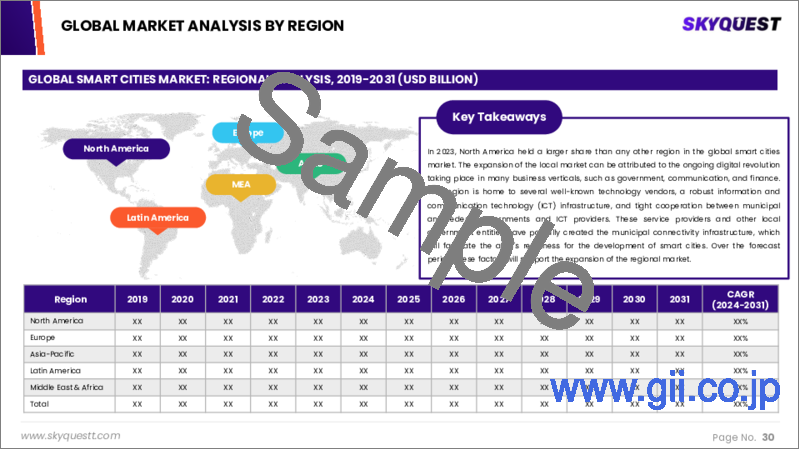|
|
市場調査レポート
商品コード
1569482
スマートシティの市場規模、シェア、成長分析、スマート輸送別、スマートユーティリティ別、スマート市民サービス別、地域別 - 産業予測、2024年~2031年Smart Cities Market Size, Share, Growth Analysis, By Smart Transportation, By Smart Utilities, By Smart Citizen Service, By Region - Industry Forecast 2024-2031 |
||||||
|
|||||||
| スマートシティの市場規模、シェア、成長分析、スマート輸送別、スマートユーティリティ別、スマート市民サービス別、地域別 - 産業予測、2024年~2031年 |
|
出版日: 2024年10月13日
発行: SkyQuest
ページ情報: 英文 157 Pages
納期: 3~5営業日
|
全表示
- 概要
- 目次
スマートシティの市場規模は、2022年に8,706億1,000万米ドルとなり、2023年の1兆943億米ドルから、2031年までには6兆8,208億米ドルに成長し、予測期間中(2024年~2031年)のCAGRは25.7%で成長する見通しです。
2023年には、北米が世界のスマートシティ市場で圧倒的な地位を占めるようになりました。これは主に、政府、通信、金融など、さまざまな分野で進行中のデジタル革命によるものです。この地域は、著名なテクノロジーベンダーの強い存在感と高度な情報通信技術(ICT)インフラを誇り、自治体や連邦当局、ICTプロバイダー間の強固な連携によって補完されています。このようなパートナーシップは、効果的な自治体間接続の基礎を築き、北米を将来のスマートシティ開拓に有利に位置づけ、予測期間を通じて市場の成長を後押しすると期待されています。一方、東南アジア太平洋は大幅な成長を遂げようとしており、CAGRは29.2%と顕著な伸びを示すと予測されています。この急成長の背景には、世界化、デジタルインフラの進歩、可処分所得の増加、全体的な経済発展など、いくつかの要因があります。アジア太平洋地域の企業は、クラウドベースのソリューションを採用するようになっており、その費用対効果の高さが、スマートビルディング、スマートユーティリティ、スマート交通、スマートガバナンスといった革新的なアプリケーションの開発を後押ししています。こうした動向は、北米と東南アジア太平洋におけるスマートシティ構想のダイナミックな状況を浮き彫りにしており、急速に発展するこれらの市場に大きな成長機会があることを浮き彫りにしています。
目次
イントロダクション
- 調査の目的
- 定義
- 市場範囲
調査手法
- 情報調達
- 二次・一次情報源
- 市場規模予測
- 市場の前提条件と制限
エグゼクティブサマリー
- 市場概要見通し
- 供給需要動向分析
- セグメント別機会分析
市場力学と見通し
- 市場力学
- 促進要因
- 機会
- 抑制要因
- 課題
- ポーターの分析
主要な市場の考察
- 技術分析
- ケーススタディ分析
- 価格分析
- バリューチェーン分析
- 特許分析
- 貿易分析
- 顧客と購買基準の分析
- 市場のエコシステム
- 規制情勢
- イノベーションマトリクス
- 主要な投資分析
- 主要な成功要因
- 競合の程度
スマートシティ市場:スマート輸送別
- 市場概要
- オファリング
- ソリューション
- スマートチケット
- トラフィック管理
- 駐車場管理
- 交通監視
- 乗客情報
- コネクテッドロジスティクス
- その他のスマート輸送ソリューション
- サービス
- コンサルティング
- デプロイメント・統合
- インフラストラクチャの監視と管理
- タイプ
- 道路
- 鉄道
- 航空路
スマートシティ市場:スマートビルディング別
- 市場概要
- オファリング
- ソリューション
- 建物のインフラストラクチャ管理
- 駐車場管理システム
- スマート水管理システム
- エレベーター・エスカレーター管理システム
- セキュリティ・緊急管理
- アクセス制御システム
- ビデオ監視システム
- 安全システム
- エネルギー管理
- HVAC制御システム
- 照明システム
- ネットワーク管理
- 統合職場管理システム
- サービス
- コンサルティング
- デプロイメント・統合
- インフラストラクチャの監視と管理
- タイプ
- 住宅
- 商用
- 産業
スマートシティ市場:スマートユーティリティ別
- 市場概要
- オファリング
- ソリューション
- 高度な計測インフラストラクチャ
- メーターデータ管理
- メーターデータ分析
- スマートメーター
- その他の解決策
- 配布管理システム
- 変電所の自動化
- その他のスマートユーティリティソリューション
- サービス
- コンサルティング
- デプロイメント・統合
- インフラストラクチャの監視と管理
- タイプ
- エネルギー
- ガス
- 水
- その他のタイプ
スマートシティ市場:スマート市民サービス
- 市場概要
- スマートヘルスケア
- 医療機器
- システム・ソフトウェア
- サービス
- スマート教育
- ソリューション
- サービス
- スマート公共安全
- ソリューション
- サービス
- スマート街路照明
- 電子政府
- ソリューション
- サービス
スマートシティ市場規模:地域別
- 市場概要
- 北米
- 米国
- カナダ
- 欧州
- ドイツ
- スペイン
- フランス
- 英国
- イタリア
- その他欧州地域
- アジア太平洋
- 中国
- インド
- 日本
- 韓国
- その他アジア太平洋
- ラテンアメリカ
- ブラジル
- その他ラテンアメリカ地域
- 中東・アフリカ(MEA)
- GCC諸国
- 南アフリカ
- その他中東・アフリカ地域
競合情勢
- 上位5社の比較
- 主要企業の市場ポジショニング(2023年)
- 主要な市場企業が採用した戦略
- 市場における最近の活動
- 主要企業の市場シェア(2023年)
主要企業プロファイル
- Cisco Systems, Inc.(US)
- IBM Corporation(US)
- Intel Corporation(US)
- Siemens(Germany)
- Microsoft(US)
- Hitachi(Japan)
- Schneider Electric(France)
- Huawei(China)
- NEC(Japan)
- ABB(Switzerland)
- Ericsson(Sweden)
- Oracle(US)
- Fujitsu(Japan)
- Honeywell(US)
- Accenture(Ireland)
- Motorola(US)
- Google(US)
- TCS(India)
- Nokia(Finland)
- Samsung(South Korea)
Smart Cities Market size was valued at USD 870.61 billion in 2022 and is poised to grow from USD 1094.3 billion in 2023 to USD 6820.8 billion by 2031, growing at a CAGR of 25.7% during the forecast period (2024-2031).
In 2023, North America emerged as the dominant player in the global smart cities market, primarily driven by an ongoing digital revolution across various sectors including government, communication, and finance. This region boasts a strong presence of renowned technology vendors and an advanced information and communication technology (ICT) infrastructure, complemented by robust collaboration between local municipalities and federal authorities as well as ICT providers. These partnerships have laid the groundwork for effective municipal connectivity, positioning North America well for future smart city developments, which are expected to bolster market growth throughout the forecast period. Meanwhile, Southeast Asia-Pacific is on track for substantial growth, projected to achieve a remarkable compound annual growth rate (CAGR) of 29.2%. This surge is fueled by several factors including globalization, advancements in digital infrastructure, increased disposable income, and overall economic progress. Enterprises in the Asia-Pacific region are increasingly adopting cloud-based solutions, recognizing their cost-effectiveness, which in turn is driving the development of innovative applications such as smart buildings, smart utilities, smart transportation, and smart governance. These trends underscore the dynamic landscape of smart city initiatives across both North America and Southeast Asia-Pacific, highlighting the significant opportunities for growth in these rapidly evolving markets.
Top-down and bottom-up approaches were used to estimate and validate the size of the smart cities market and to estimate the size of various other dependent submarkets. The research methodology used to estimate the market size includes the following details: The key players in the market were identified through secondary research, and their market shares in the respective regions were determined through primary and secondary research. This entire procedure includes the study of the annual and financial reports of the top market players and extensive interviews for key insights from industry leaders such as CEOs, VPs, directors, and marketing executives. All percentage shares split, and breakdowns were determined using secondary sources and verified through Primary sources. All possible parameters that affect the markets covered in this research study have been accounted for, viewed in extensive detail, verified through primary research, and analyzed to get the final quantitative and qualitative data.
smart cities Market Segmental Analysis
The global smart cities market is segmented into smart transportation, smart utilities, smart citizen service, and region. By smart transportation, the market is classified into smart ticketing and connected logistics. Depending on smart utilities, it is categorized into offering and services. According to smart citizen service, the market is bifurcated into smart healthcare and smart street lighting. Regionally, it is analyzed across North America, Asia-Pacific, Latin America, Europe, and Middle East & Africa.
Driver of the smart cities Market
The burgeoning investment in smart city initiatives serves as a significant market driver for the smart cities sector. With governments in emerging regions funneling billions into innovative designs, the integration of advanced technologies enhances urban infrastructure, public services, and sustainability. For instance, efficiency in waste management becomes a reality through smart solutions, improving urban living standards. Additionally, the decreasing costs of Internet of Things (IoT) sensors facilitate widespread adoption and deployment of smart technologies, further accelerating market growth. As cities increasingly embrace digital transformation, the demand for smart city solutions will continue to rise, creating vast opportunities for stakeholders in this dynamic market.
Restraints in the smart cities Market
The smart cities market faces a notable restraint due to the substantial financial burden it imposes on resource-constrained economies. The high costs of developing and integrating smart city solutions, often exceeding $100 million for mid-sized towns, create a significant barrier to entry. While smart infrastructure promises improvements in operational efficiency and energy conservation, the daunting initial investment and ongoing maintenance expenses deter many municipalities from pursuing these advanced technologies. Consequently, this economic limitation may hinder the widespread adoption of smart city initiatives, restricting their transformative potential in enhancing urban living conditions and overall sustainability in less affluent regions.
Market Trends of the smart cities Market
The smart cities market is experiencing a significant growth trend, fueled by rapid advancements in technologies such as Artificial Intelligence (AI), Machine Learning (ML), the Internet of Things (IoT), cloud computing, and data analytics, particularly in developing regions. These innovations facilitate enhanced connectivity and data-sharing capabilities, enabling centralized control systems to integrate and manage information more efficiently from diverse urban sources. As cities harness these technologies, they not only optimize resource management and enhance public safety but also prioritize environmental sustainability and citizen privacy. This convergence of technology in urban planning is redefining the fabric of urban life and driving investment in smart city initiatives globally.
Table of Contents
Introduction
- Objectives of the Study
- Definitions
- Market Scope
Research Methodology
- Information Procurement
- Secondary & Primary Data Sources
- Market Size Estimation
- Market Assumptions & Limitations
Executive Summary
- Market Overview Outlook
- Supply Demand Trend Analysis
- Segmental Opportunity Analysis
Market Dynamics & Outlook
- Market Dynamics
- Drivers
- Opportunities
- Restraints
- Challenges
- Porters Analysis
- Competitive rivalry
- Threat of Substitute Products
- Bargaining Power of Buyers
- Threat of New Entrants
- Bargaining Power of Suppliers
Key Market Insights
- Technology Analysis
- Case Study Analysis
- Pricing Analysis
- Value Chain Analysis
- Patent Analysis
- Trade Analysis
- Customer & Buying Criteria Analysis
- Ecosystem of the Market
- Regulatory Landscape
- Innovation Matrix
- Top Investment Analysis
- Key Success Factor
- Degree of Competition
Global Smart Cities Market by Smart Transportation
- Market Overview
- Offering
- Solutions
- Smart ticketing
- Traffic management
- Parking management
- Traffic surveillance
- Passenger information
- Connected logistics
- Other smart transportation solutions
- Services
- Consulting
- Deployment & integration
- Infrastructure monitoring & management
- Type
- Roadways
- Railways
- Airways
Global Smart Cities Market by Smart Building
- Market Overview
- Offering
- Solutions
- Building infrastructure management
- Parking management system
- Smart water management system
- Elevators and escalators management system
- Security & emergency management
- Access control system
- Video surveillance system
- Safety system
- Energy management
- HVAC control systems
- Lighting systems
- Network management
- Integrated workplace management system
- Services
- Consulting
- Deployment & integration
- Infrastructure monitoring & management
- Type
- Residential
- Commercial
- Industrial
Global Smart Cities Market by Smart Utility
- Market Overview
- Offering
- Solutions
- Advanced metering infrastructure
- Meter data management
- Meter data analytics
- Smart meters
- Other solutions
- Distribution management system
- Substation automation
- Other smart utilities solutions
- Services
- Consulting
- Deployment & integration
- Infrastructure monitoring & management
- Type
- Energy
- Gas
- Water
- Other types
Global Smart Cities Market by Smart Citizen Service
- Market Overview
- Smart healthcare
- Medical devices
- Systems & software
- Services
- Smart education
- Solutions
- Services
- Smart public safety
- Solutions
- Services
- Smart street lighting
- E-Governance
- Solutions
- Services
Global Smart Cities Market Size by Region
- Market Overview
- North America
- USA
- Canada
- Europe
- Germany
- Spain
- France
- UK
- Italy
- Rest of Europe
- Asia Pacific
- China
- India
- Japan
- South Korea
- Rest of Asia-Pacific
- Latin America
- Brazil
- Rest of Latin America
- Middle East & Africa (MEA)
- GCC Countries
- South Africa
- Rest of MEA
Competitive Landscape
- Top 5 Player Comparison
- Market Positioning of Key Players, 2023
- Strategies Adopted by Key Market Players
- Recent Activities in the Market
- Key Companies Market Share (%), 2023
Key Company Profiles
- Cisco Systems, Inc. (US)
- Company Overview
- Business Segment Overview
- Financial Updates
- Key Developments
- IBM Corporation (US)
- Company Overview
- Business Segment Overview
- Financial Updates
- Key Developments
- Intel Corporation (US)
- Company Overview
- Business Segment Overview
- Financial Updates
- Key Developments
- Siemens (Germany)
- Company Overview
- Business Segment Overview
- Financial Updates
- Key Developments
- Microsoft (US)
- Company Overview
- Business Segment Overview
- Financial Updates
- Key Developments
- Hitachi (Japan)
- Company Overview
- Business Segment Overview
- Financial Updates
- Key Developments
- Schneider Electric (France)
- Company Overview
- Business Segment Overview
- Financial Updates
- Key Developments
- Huawei (China)
- Company Overview
- Business Segment Overview
- Financial Updates
- Key Developments
- NEC (Japan)
- Company Overview
- Business Segment Overview
- Financial Updates
- Key Developments
- ABB (Switzerland)
- Company Overview
- Business Segment Overview
- Financial Updates
- Key Developments
- Ericsson (Sweden)
- Company Overview
- Business Segment Overview
- Financial Updates
- Key Developments
- Oracle (US)
- Company Overview
- Business Segment Overview
- Financial Updates
- Key Developments
- Fujitsu (Japan)
- Company Overview
- Business Segment Overview
- Financial Updates
- Key Developments
- Honeywell (US)
- Company Overview
- Business Segment Overview
- Financial Updates
- Key Developments
- Accenture (Ireland)
- Company Overview
- Business Segment Overview
- Financial Updates
- Key Developments
- Motorola (US)
- Company Overview
- Business Segment Overview
- Financial Updates
- Key Developments
- Google (US)
- Company Overview
- Business Segment Overview
- Financial Updates
- Key Developments
- TCS (India)
- Company Overview
- Business Segment Overview
- Financial Updates
- Key Developments
- Nokia (Finland)
- Company Overview
- Business Segment Overview
- Financial Updates
- Key Developments
- Samsung (South Korea)
- Company Overview
- Business Segment Overview
- Financial Updates
- Key Developments





